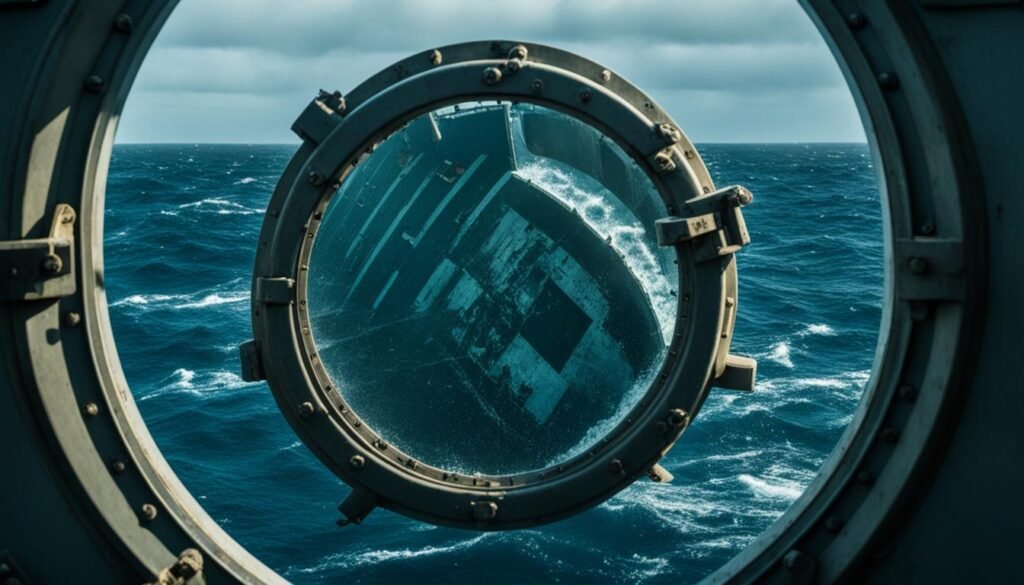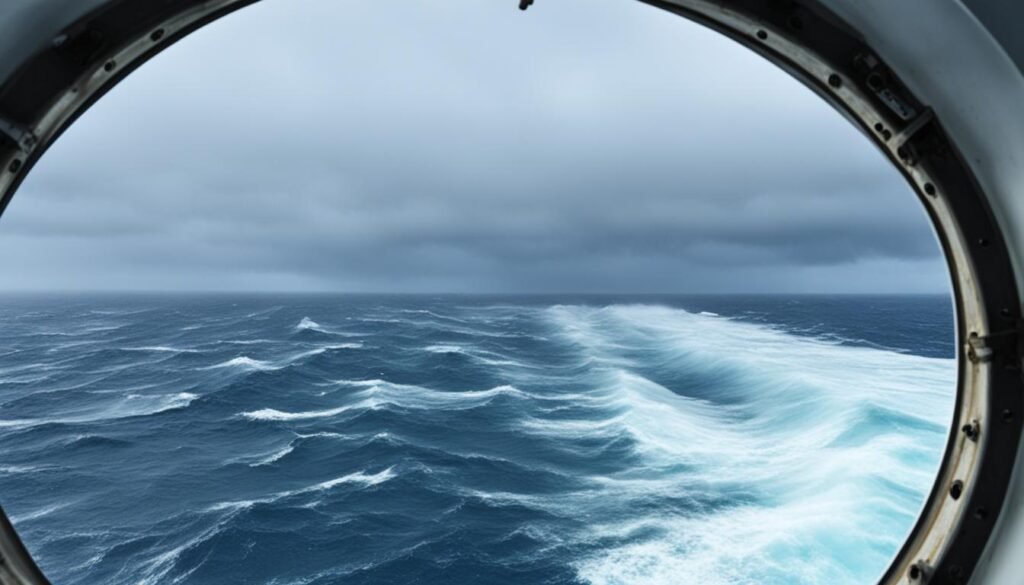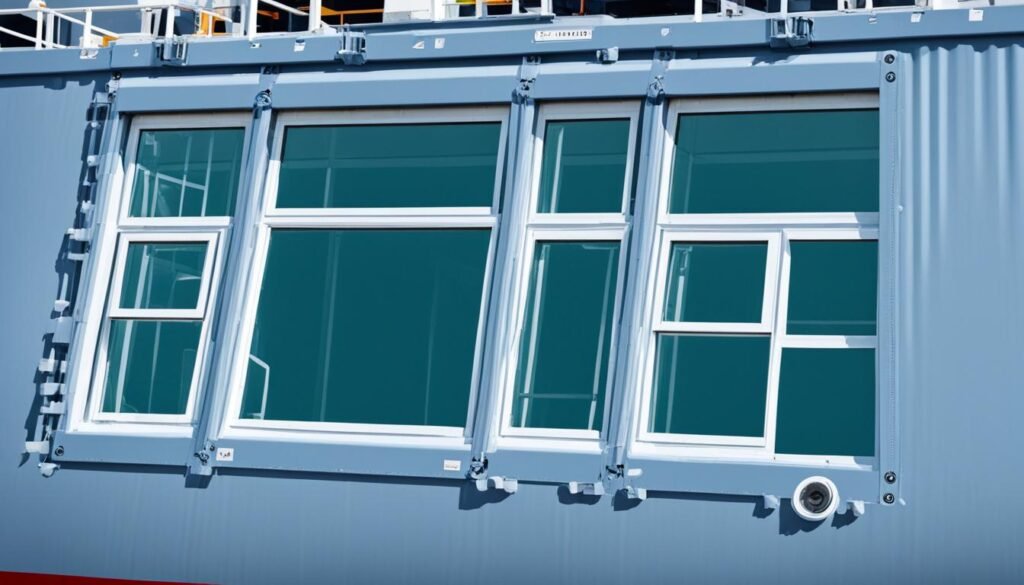Have you ever watched cargo ships move in and out of the harbor? Wondered why their windows, called portholes, can’t open? It’s because these ships are built for safety and security. Their design keeps everyone safe.
Cargo ships sail through the open ocean, facing changing weather. They must handle huge waves and winds. The round shape of portholes helps them stay safe and secure.

Round portholes are stronger than square ones. They don’t break easily under pressure. This is key for maritime safety and following cargo vessel regulations.
Not being able to open portholes might seem bad. But it’s a key safety feature. It keeps the crew, cargo, and ship safe. Every part of a ship is designed with safety in mind.
Decisions on ship design focus on crew safety and efficiency. This ensures a safe and efficient journey at sea.
Understanding Ship Portholes
Ship portholes, also known as “side scuttles,” are round windows on the sides of ships. They let in natural light and air, which is key for the crew. These windows have been a part of ship design for a long time, keeping their unique shape and purpose.
Portholes are placed to give the best view of the ocean. They were first made to bring light and air into areas that were hard to ventilate. This helped the crew work for long hours. Now, portholes are a common feature in every room and cabin, crucial for the ship’s design and function.
Portholes: A Unique Design for Maritime Vessels
Ship portholes stand out with their round shape, unlike windows on land. They are made for the best ocean view and have hinged ends for better airflow. The materials used include stainless steel, aluminum, brass, bronze, and iron, with brass and bronze being top choices for their durability.
The glass in portholes is made using sand-casting. These windows are big, about two feet in diameter, and can be as heavy as 100 pounds. They are built tough to withstand sunlight, seawater, and rain. The glass is thin but strong, less than two inches thick, for safety.

Most portholes on modern cargo ships don’t open wide. They only open a little for light. This is because they need to be weather-tight and keep the crew safe. While some portholes in crew areas are open for air, most are for light and look.
Construction and Materials
The construction of cargo ship portholes is strict, following nautical transportation regulations and maritime industry practices. Common materials include stainless steel, aluminum, brass, bronze, and iron. The glass is made through sand-casting, a process that heats and cools a mix of silica, lime, and ash to create the glass.
Brass and bronze are often chosen over iron and steel because they don’t rust easily in seawater. The glass is set in a metal cover or frame with a shaft or screw. This keeps it watertight and protects the ship’s windows from damage. Such careful design and engineering are key for safe seafarer living conditions.
| Material | Advantages |
|---|---|
| Stainless Steel | Corrosion-resistant, durable |
| Aluminum | Lightweight, corrosion-resistant |
| Brass | Corrosion-resistant, attractive appearance |
| Bronze | Corrosion-resistant, durable, attractive appearance |
| Iron | Affordable, strong |
The choice of materials for cargo ship portholes balances ship structural engineering, maritime transportation needs, and marine engineering standards. Builders must think about the challenges of oceangoing vessel requirements and nautical architecture principles. This ensures the vessel is safe and strong during its operations.

Structural Integrity and Safety
The round shape of portholes is key to keeping ships strong against the ocean’s pressure. Square or rectangular windows can’t handle stress as well, especially at corners. This makes round windows better for ships, keeping them safe and watertight.
Over time, the maritime industry has worked hard to make ships safer. The 19th century showed us why this is so important, with many ships sinking and lives lost. For instance, in 1873-4, 411 ships sank near the UK, taking 506 lives with them.
Between 1867 and 1882, 33,427 seafarers and 5,987 passengers died in British ships. During this period, 16,393 ships were lost at sea.
After these tragedies, laws and standards were created to make ships safer. In 1906, a law made it mandatory for foreign ships to have a load line when visiting British ports. This ensured they weren’t overloaded and could handle the ocean’s pressure.
In 1903, Germany passed laws about freeboard for ships. This showed how important it is to design and build ships right to stay stable and buoyant.
The International Convention for the Safety of Life at Sea (SOLAS), 1974, and its Protocol of 1988 set global safety standards. These rules cover different types of ships, like cargo and passenger vessels. They make sure ships meet safety standards.
The Vessel Fire Safety Regulations also have rules for ship materials, equipment, and systems. This helps make the maritime industry safer for everyone.
Why Windows on Cargo Ships Can’t Be Opened?
Cargo ships have fixed windows called portholes for important reasons. These windows can’t open to keep the ship safe and strong. This is key, especially when the weather is rough.
The round shape of portholes helps the ship stay strong against the ocean’s pressure. Square or rectangular windows might break more easily. This shape is key to keeping the ship safe and secure.
Keeping the air inside the ship tight is also crucial. It helps protect the cargo and keep the crew safe. This is why portholes don’t open on cargo ships.
Rules and standards for shipping also require sealed windows. This keeps everyone and everything safe during transport.
So, fixed portholes are essential for the ship’s safety and following the rules. They help keep the ship strong, the air tight, and everyone safe. This makes sure shipping can happen safely in all kinds of weather.
Crew Quarters and Ventilation
In the crew quarters of cargo ships, portholes open a bit for airflow. But, most portholes on modern ships don’t open. They let in light and add to the ship’s look, not for air. This design keeps the ship safe and the crew dry, which is key for carrying cargo and keeping everyone safe at sea.
Good ventilation and a strong hull are key in ship design. They keep the ship stable and safe, protecting the crew and cargo. By stopping leaks and keeping the cargo area pressurized, shipmakers follow important safety rules. This lowers the chance of emergencies and damage to the environment during trips.
Ventilation Systems and Porthole Design
Portholes aren’t the main way to get air in, but the ship’s ventilation system is crucial. It brings in fresh air, controls temperature, and keeps humidity right. Portholes and the ventilation work together to make the ship’s air quality good for the crew.
| Key Ventilation System Features | Benefits for Crew and Cargo |
|---|---|
| Pressurized hull design | Maintains watertight integrity and protects against water leaks |
| Cargo hold pressurization | Ensures proper temperature and humidity levels for cargo preservation |
| Strategic porthole placement | Provides natural lighting and aesthetic appeal in crew quarters |
| Efficient air circulation | Enhances crew comfort and well-being during long voyages |
Modern cargo ships focus on keeping the crew and cargo safe and comfortable. They use smart design and engineering to meet safety rules and protect against risks. This way, goods can move safely across the seas, meeting high safety standards.
Maritime Regulations and Standards
The design and construction of cargo ship portholes follow strict maritime regulations and standards. These rules make sure the windows can handle the tough conditions of the sea. They must be strong, safe, and keep water out. Groups like the International Maritime Organization set the rules for porthole materials and how they’re made.
They also make sure portholes can handle bad weather, high pressure, and emergencies.
The International Convention for the Safety of Life at Sea (SOLAS) was made in 1974. It’s a key safety rule for ships. Resolution MSC.392(95) updated SOLAS in 2016. The International Code of Safety for Ships using Gases or other Low-flashpoint Fuels (IGF Code) became a must-have rule in 2016 too.
In 2020, new rules for ships using methyl/ethyl alcohol as fuel were set. These rules help ships using new fuels stay safe. They cover things like preventing fires and keeping fuel safe.
| Regulation | Key Highlights |
|---|---|
| Resolution MSC.280(70) | Set a 0.50% sulphur limit for ship fuel in 2020 worldwide |
| MARPOL Annex VI | Banned systems with HCFCs on ships made after 1 January 2020 |
| Resolution MSC.402(96) | Focuses on keeping lifeboats and rescue gear in good shape as per SOLAS rules |
| Resolution MSC.404(96) | New rules for firefighting foam, escape routes, and window strength on ships with fewer than 36 passengers |
These maritime regulations and standards make sure cargo ships are safe and work well. They cover important parts like portholes. These rules keep getting updated to meet new challenges in the shipping world.
Cargo Security and Protection
Cargo ship portholes with fixed, non-opening designs are key to keeping goods safe. These sealed, pressurized areas protect the cargo from the environment and tampering. This keeps the shipment secure.
Recently, maritime security has faced threats. In 2022, Iranian-backed Houthi rebels took a merchant ship in the Red Sea. A Norwegian tanker was also hit by a missile there. To fight these threats, the industry uses Long Range Acoustic Devices (LRADs) and other tactics.
The design of portholes helps keep cargo ships secure. They provide structural stability and watertight seals. With Best Management Practices (BMP 5), goods are safely moved across oceans. This is true even with threats like the Ukraine conflict and Houthi attacks in the Red Sea.
| Security Measure | Description | Effectiveness |
|---|---|---|
| Long Range Acoustic Devices (LRADs) | In 2008, LRAD failed during the Somali pirates’ attack on the MV Biscaglia. However, some cruise ships have used LRAD and other methods to stop Somali pirates in 2005. | In 2008, LRAD failed during the Somali pirates’ attack on the MV Biscaglia. But, some cruise ships have used LRAD and other methods to stop Somali pirates in 2005. |
| Laser-based Anti-Piracy Devices | BAE Systems made a laser device that can reach up to 2,000m. But, it’s not on merchant ships yet. | It’s not clear how well these lasers work in real situations. |
| Water Cannons | Water cannons, made by Swedish firm Unifire AB, can shoot up to 5,000 litres of water a minute up to 90m away. | Water cannons have stopped some pirate attacks, especially from sea level. |
Improving cargo security is vital for the maritime industry. As more goods move around the world, the need to stay alert and adapt grows. This ensures goods are safely and securely moved everywhere.
You can also read this article for further information What Are Ship Portholes?
Conclusion
Cargo ships have fixed windows called portholes for safety and security. These windows help keep the ship strong and watertight. They also make sure the cabin is pressurized for the crew’s safety.
Portholes are round and sealed to keep the ship stable and safe. They meet all maritime rules and standards. This design helps protect the ship, its cargo, and everyone on board.
Even though portholes let in some light, their main job is to keep the ship safe. They can handle the sea’s pressure and keep crew and cargo safe. This is key for safe and secure shipping.
Not being able to open windows on cargo ships is a smart choice. It’s based on marine engineering and building standards. This design helps avoid dangers at sea and passes inspections. It keeps cargo ships safe and efficient on the world’s oceans.
FAQ About Windows on Cargo Ships
Why can’t the windows on cargo ships be opened?
Cargo ships have special windows called portholes that can’t be opened. These windows are round and let in natural light and air. They are shaped to handle the ocean’s pressure better than square windows. This shape helps prevent damage.
Portholes are key to ship design for safety and security in moving goods across oceans.
What is the purpose of portholes on cargo ships?
Portholes have been on ships for a long time. They let in light and air, which was crucial for workers in the past. Now, they’re a standard feature for everyone on the ship.
They help make the ship a better place to work and live.
What materials are used to build ship portholes?
Portholes are made from materials like stainless steel, aluminum, brass, bronze, and iron. The glass is created through a special process called sand-casting. This makes the glass strong and thick.
Brass and bronze are chosen because they don’t rust easily in saltwater. The glass is then fitted into a metal frame to keep it secure and watertight.
How does the design of portholes contribute to the ship’s structural integrity?
The round shape of portholes helps the ship stay strong against the ocean’s pressure. Square windows could break more easily. This shape is important for keeping the ship safe.
Portholes help keep the ship and its crew safe during rough seas.
Why are cargo ships designed with fixed, non-opening windows?
Cargo ships have fixed windows, or portholes, for safety. Opening windows could weaken the ship in bad weather. They also help keep the air inside the ship safe for the crew and protect the cargo.
Rules and standards also require these sealed windows for safety at sea.
Are there any exceptions for opening portholes on cargo ships?
Sometimes, portholes in crew areas can open a little for air. But most portholes on cargo ships don’t open. They’re mainly for light and look.
This design is key for keeping the ship safe and the crew protected at sea.
You might also like to read these blog posts
